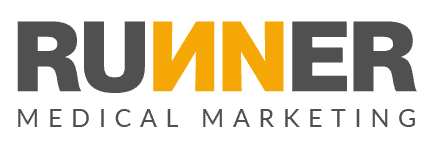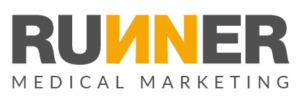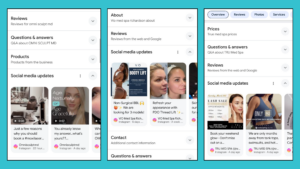
2020 is coming to an end. While it was one of the toughest years for healthcare we’re likely to see in our lifetime, the industry has proven we can be agile and adaptable; to do whatever serves our patients best.
The practices that are best positioned to grow in 2021 will be those that keep their foot on the gas – to overcome challenges and unearth new opportunities. We’ve learned so much throughout 2020, here are 5 medical marketing trends to take to heart for the year ahead.
#1 Physician Referrals Become Even More Unreliable
Healthcare providers know the importance of active referral programs. Yet with the rise of self-referrals and issues with patient follow-through, it’s becoming a necessity for practices to move beyond physician referrals for marketing. We help practices use digital marketing at the primary source of new patients – some of our practices see between 70-90% of all new patients from digital marketing, not referrals.
COVID-19 has accelerated the need to move beyond. You can no longer maintain current relationships with face-to-face methods, but more alarmingly, with primary care and specialist visits dropping, referral volume has dropped with it – an average drop of 21% according to the JAMA.
What are your options for specialists that have been reliant on referrals?
Take the Conversation Digital
Referring providers may not be jumping at the opportunity to sit down to a restaurant dinner, but that doesn’t mean you can’t connect with them. It’s the perfect time to dust off your keyboard and spend some time connecting via LinkedIn or Email. Reaching out to simply check on them can make a big impression. Then, follow up with some helpful information:
- Share how your business has changed this year
- Pass on helpful industry articles or white papers
- Share an experience you had with a recent webinar or virtual conference
Bypass Referrals with Search
Patients may be postponing their preventive health visits, but that doesn’t mean they don’t need specialist care. Rather than waiting to consult their primary care doc, many patients are turning straight to the internet to research their symptoms or contact a specialist directly. In fact, 1 in 4 visits to specialists are now self-referrals. Paid and organic search engine marketing can be competitive, but here are a few tactics to get ahead of the competition.
- Start by focusing on the “center” of your bullseye – the conditions and treatments that are most likely to convert into patients
- Make sure you’re spending enough – many practices write of search engine marketing because they don’t spend enough to see conversions. It’s all about your revenue-per-patient
- Be transparent about your COVID safety measures
- Hire an expert in Search Engine Marketing to do this work – it is complex and requires good keyword research, expert management, and even better conversion optimization
Invest in Your Message
When patients are referred by a physician they trust, they know that they can trust you and your practice, too. However, as referrals decrease and patients come in from other channels, specialists must work harder to establish that trust ahead of time. This means taking the time to evaluate your website, outreach materials, social media, and even your call center. When patients feel they can trust your practice, they are more likely to make contact and show up for appointments. When your message is clear and concise across all areas, that trust comes easier. Here are a few notable places patients might check:
- Your website
- Your business/maps listings
- Your physician listings (such as healthgrades.com)
- Your social media channels
- Your call handling
#2 Digital Practice Transformation Accelerates
As a marketing partner for medical practices, it’s crucial for us to stay ahead of the curve when it comes to the latest technology. However, it’s not just marketing technologies that have caused seismic changes.
In recent years we’ve witnessed a variety of changes occurring in the operations of practices thanks to software that streamline processes. Of these changes, there’s one area of particular importance that stands out — the patient experience.
While we’ve talked a lot about telehealth/telemedicine this year — which was by far the most notable trend of 2020 — the use of technology and software in other areas of the practice is also surging. As a result, we’re seeing vast improvements in the patient experience that go beyond telehealth. Here are a few:
Booking Appointments
The experience in booking appointments is now more streamlined than ever before, with many practices putting the power directly in the patient’s hands thanks to online booking software. No more sorting out available dates and times over the phone, or even worse, back and forth in trying to get patients on the phone. Now, in just a couple of clicks, patient information and appointment details are loaded into the EHR and/or CRM without any work for internal staff.
Patient Communication
With every new year, it seems that communication between patients and practices (both providers and staff) has become more and more direct. From email and text messages to live chat and patient portals, the ways for patients to connect with their provider or office staff are now primarily digital. This is due in large part to practices having the option to open up multiple lines of direct communication.
Automation of these channels is taking it one step further with things like appointment confirmations, follow-ups, and reminders—making for less internal work and fewer potential issues for oversight by front-desk staff.
Insurance verification
Insurance verification plays a critical role in the orthopedic space. Not only do many providers have very different agreements in place with various networks and health plans (if they have any at all), but many practices rely on the insurance verification or eligibility process as a part of the pre-screening process.
Thanks to online insurance verification tools that integrate with EHRs and CRMs, practices now have a big boost in terms of efficiency in dealing with insurance pre-qualification, in some cases, automating the process completely.
The above trends are the reason why we offer clients marketing enabled by a platform that can automate or streamline booking, as well as trigger digital messaging across platforms to better engage leads and convert them into patients.
#3 Increased Digital Marketing Spending for Practices
In 2021, the healthcare industry is projected to increase spending in digital marketing by 18% to $11.25 billion — its biggest increase in two years, according to Emarketer.
We believe that increase will end up being more and will continue in 2021. Here are a few important underlying considerations.
Referrals Have Been Declining for Years
According to a doctor.com 2020 consumer survey, the death of referrals is imminent.
Patients are almost twice as likely to rely on Internet resources over using traditional referrals to find a provider. Referrals have declined by 44% since 2018.
As patient reliance on the internet for choosing their provider increases, medical practices must adapt to these user tendencies so that these potential patients can find providers where they’re looking – online. Adapting to this trend requires a refocus of marketing investments from traditional to digital channels. Simply put, you have to reach patients where they are.
Increased Competition = Increased Costs
As more medical practices increase their investments in paid media like Google and Facebook, the competition for ad space increases. As a direct result, the cost for ad space increases.
To put this increase in competition in perspective, the healthcare and pharma industry will make up 7.1% of all US digital ad spending for 2020 — more than the entertainment industry (5.2%), media (4.7%), and travel industry (2.4%).
But it’s not just about spending, increased competition is a real consideration. Many new telemedicine practices have started within the last 6 months. A practice that had no competitors in its local market may now have multiple telehealth providers to compete against.
How Can I Stay Competitive Without Increasing My Budget?
Don’t spread yourself too thin. If you have a limited budget, it’s better to dominate Facebook and Google before you try to compete across many channels.
Furthermore, getting hyper-targeted with your audience in each channel is key. You must be confident each impression you’re paying for is going towards someone who is qualified to actually become a patient — whether that’s zeroing in on keyword, location, age, interest, or behavior.
Lastly, be honest about your digital marketing budget and set your expectations accordingly. If your revenue per patient is 10,000 you should be willing to spend more than a few hundred dollars each month. If you have trouble, like many practices, setting a budget, we’ve outlined 3 simple ways to determine a digital marketing budget.
#4 Advanced Targeting Will Keep Getting Better
Targeting is perhaps one of the most important aspects of your practice marketing, yet very few medical practices take advantage of all the advanced targeting options available in 2021 to help you find patients.
Search Outside of Search Platforms
The most targeted way to find new patients is by identifying people searching for conditions and treatments you care about. But did you know that search engines aren’t the only place you can use “search keyword” targeting? One great example is Youtube. Since it’s owned by Google, you can target ads on Youtube with the searches they’re making on Google. This “custom intent” audience is just one example of expanding your search campaign to another platform.
Contextual Targeting
Another example of targeting that most practices don’t take advantage of is contextual targeting. This is using the content on a page to determine the ad that shows up. This kind of targeting is used extensively in Native Advertising, where your ad often shows up in editorial content, like articles. You can tell someone is researching the conditions or treatments you care about by the content in the article.
3rd Party Programmatic
Through programmatic advertising, the same kinds of sophisticated data that pharmaceutical companies use to target patients are available, even to single-location practices. This kind of targeting can include OTC medication purchase behaviors, condition targeting based on behavior across many websites, even the propensity for individuals to have specific conditions.
Advertising targeting continues to become more advanced but is only being utilized by practices willing to invest across multiple digital platforms.
#5 Marketing Automation in Patient Engagement
COVID-19 made a huge impact on how patients (and potential patients) experience healthcare. The concept of telehealth became widely available, stale waiting rooms became obsolete, and reducing physical patient contact is now the norm. Patients are engaging with physicians and medical practices in different ways… and as that communication becomes digital, those ways are becoming automated.
The Marketing Automation Opportunity for Practices: Empathy
Let’s say you are going in for a microdiscectomy. You call to schedule your microdiscectomy procedure. An office team member calls you the day before to confirm your appointment and you show up the next day to have your surgery. Then after the microdiscectomy, you go home with a few PDFs about care and recovery. Then you do it all over again 2 weeks later, starting with a call to schedule your post-surgery check-in.
The cycle continues. . . There is no proactive communication or post-surgery consideration that implies you are anything other than another appointment on the calendar.
So, what does marketing automation that focuses on patient care look like? It’s all about information sharing and communication to enhance the patient experience. Marketing automation in these key areas will continue to grow in 2021:
Appointment Scheduling
Putting the power in the patients’ hands with online booking will continue to be a priority. Letting them see what times and physicians are available so they are empowered to book on their own. But don’t stop there. Automate email and text confirmations and appointment reminders.
In-person Appointments
Don’t make the patient figure it all out on their own. Communication is key. Make sure they know how to get to your office, where to park, and how early they need to arrive with an automated email or text 24 hours before their appointment.
Telehealth Appointments
For most, the concept of receiving healthcare via a video conference is new. Communicating how this works to patients, what to expect, and any technology needs will ease the learning curve on this new process. Plus, all of this communication can be, you guessed it, automated.
Reviews and Testimonials
With referrals all but dead, it’s important to leverage word of mouth as much as possible and this includes reviews and testimonials. Marketing automation tools enable review curation campaigns that send an email and/or text messages to patients prompting them to rate and review their experience at your practice.
Nurture Prospects Into Patients
In order to engage with potential patients in a way that is meaningful and relevant to them, you need to leverage marketing automation to create email and SMS campaigns that deliver timely, targeted emails based on their specific need or interest. For example, if a prospect filled out a form on the low back pain page of your site, don’t send them random emails about ankle sprains. Consider this automated flow instead.
- A user fills out a form on the low back pain page of your website and you call them immediately.
- Wait 2 Days
- Sent an SMS message: “Did you know that disc degeneration is the leading cause of low back pain in adults. Call today to schedule your free spine health assessment.”
- Wait 5 Days
- Send an email: “10 Stretches to Relieve Low Back Pain”
- Wait 8 Days
- Send an email: “Understanding Your Spine Health is Important to Us”
- Wait 14 Days
- Send an SMS Message: “We can see you for your free spine health assessment on Tuesday at 11 am, can you make it?”
- Wait 30 Days
- Send an email: “Ignoring Your Back Pain Can Lead to Serious Risk”
Healthcare and medical marketing automation help busy surgeons and practice managers develop relationships with their patients; show that they are more than just an appointment. Automation is at the forefront of accelerated practice growth. If you aren’t exploring the vast world of marketing automation tools and opportunities, you are missing out on practice growth.
Choosing Growth in 2021
It’s safe to say we are all hoping that 2021 is better than 2020. Despite the challenges of this year, the practices that have embraced change are the best positioned to succeed.
The above trends are all about modernizing your practice operations and marketing to match the needs of your patients. If you are ready to put these trends to work, we can help. Book a free consultation today!




